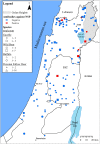Seroprevalence of Foot-and-Mouth Disease in Susceptible Wildlife in Israel
- PMID: 27200364
- PMCID: PMC4842776
- DOI: 10.3389/fvets.2016.00032
Seroprevalence of Foot-and-Mouth Disease in Susceptible Wildlife in Israel
Abstract
Foot-and-mouth disease (FMD) epidemics recur in Israel almost every year. Wild even-toed ungulates are seldom affected during these epidemics. The seroprevalence of FMD in wild ungulates during 2000 and 2005-2013 was estimated using anti-non-structural proteins ELISA. Overall, 209 samples were tested, comprising sera of 120 wild boar (Sus scrofa lybicus), 64 mountain gazelles (Gazella gazella gazella), 6 water buffaloes (Bubalus bubalis), and 19 Persian fallow deer (Dama dama mesopotamica). None of the tested animals presented clinical signs of FMD during blood collection. Sixteen samples [7.7% (95% confidence interval (CI95%) = 4.4-12.1%)] were found to be seropositive. Fifteen out of 120 samples (12.5%) from wild boar were seropositive, compared with only 1 out of 89 samples (1.1%) from all other species combined (Fisher's exact test: p = 0.003). Most of the positive samples obtained from wild boar [13/15 (86.7%)] were collected during 2007, and analysis was restricted to that year and species only. The seroprevalence of FMD in this species during 2007 was estimated at 54.2% (CI95% = 32.8-74.5%; n = 24). A significant infection cluster, comprising nine seropositive samples collected in three different locations, was identified in the north-eastern part of Israel. These findings indicate that wild boar was affected during the 2007 FMD epidemic, even though wild boar presenting FMD typical clinical signs were not observed during that year. The actual role of wild boar in the spread of FMD virus in this epidemic, however, could not be determined. The negligible seroprevalence of FMD found for all other surveillance years indicates that ongoing circulation of FMD among wildlife in Israel is unlikely. It is concluded that while the role of wildlife species in the dynamics of FMD in Israel is usually limited, there might be occasions, in which wildlife plays a part in the spread of the virus.
Keywords: FMD; NSP; prevalence; wild boar; wildlife.
Figures


Similar articles
-
Surveillance of foot-and-mouth disease (FMD) in susceptible wildlife and domestic ungulates in Southeast of Bulgaria following a FMD case in wild boar.Vet Microbiol. 2013 Sep 27;166(1-2):84-90. doi: 10.1016/j.vetmic.2013.05.016. Epub 2013 Jun 14. Vet Microbiol. 2013. PMID: 23830685
-
Assessing the potential spread and maintenance of foot-and-mouth disease virus infection in wild ungulates: general principles and application to a specific scenario in Thrace.Transbound Emerg Dis. 2016 Apr;63(2):165-74. doi: 10.1111/tbed.12240. Epub 2014 Jun 6. Transbound Emerg Dis. 2016. PMID: 24903641
-
FMD virus spillover from domestic livestock caused outbreak in captive wild ungulates: First report from Pakistan.Acta Trop. 2022 Jul;231:106439. doi: 10.1016/j.actatropica.2022.106439. Epub 2022 Apr 1. Acta Trop. 2022. PMID: 35378060
-
Foot and mouth disease: a look from the wild side.J Wildl Dis. 2013 Oct;49(4):759-85. doi: 10.7589/2012-11-276. J Wildl Dis. 2013. PMID: 24502706 Review.
-
Foot-and-mouth disease in the Americas: epidemiology and ecologic changes affecting distribution.Ann N Y Acad Sci. 2004 Oct;1026:73-8. doi: 10.1196/annals.1307.009. Ann N Y Acad Sci. 2004. PMID: 15604472 Review.
Cited by
-
Scientific Opinion on the assessment of the control measures for category A diseases of Animal Health Law: Foot and Mouth Disease.EFSA J. 2021 Jun 8;19(6):e06632. doi: 10.2903/j.efsa.2021.6632. eCollection 2021 Jun. EFSA J. 2021. PMID: 34136003 Free PMC article.
References
-
- Valdazo-Gonzalez B, Polihronova L, Alexandrov T, Normann P, Knowles NJ, Hammond JM, et al. Reconstruction of the transmission history of RNA virus outbreaks using full genome sequences: foot-and-mouth disease virus in Bulgaria in 2011. PLoS One (2012) 7(11):e49650.10.1371/journal.pone.0049650 - DOI - PMC - PubMed
-
- Hargreaves SK, Foggin CM, Anderson EC, Bastos AD, Thomson GR, Ferris NP, et al. An investigation into the source and spread of foot and mouth disease virus from a wildlife conservancy in Zimbabwe. Rev Sci Tech (2004) 23(3):783–90. - PubMed
LinkOut - more resources
Full Text Sources
Other Literature Sources

